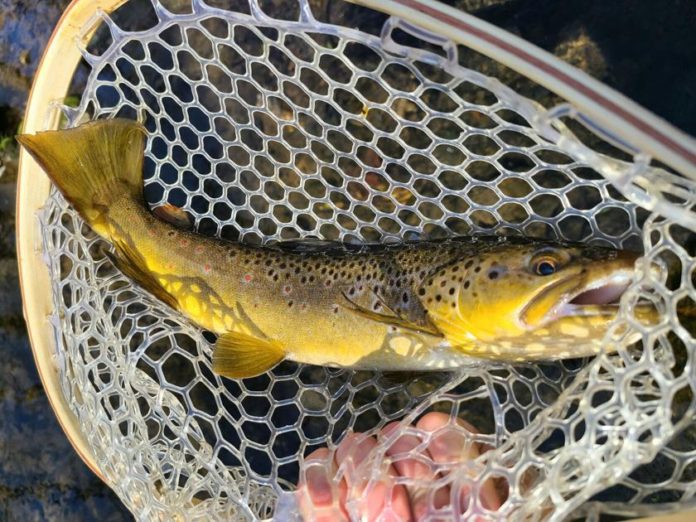Summer stream trout fishing in Minnesota’s driftless region is one way to pass the time when you are waiting on outboard motor parts to ship to your door.
Being boatless for a few weeks has been tolerable since the Minnesota and Mississippi rivers are so low that I’m not sure I’d be boating them, anyway. I’ve taken time to travel and fish with others while my boat is out of action and capped it off recently with a day trip to the driftless region.
Much like the rest of the state, Minnesota’s southeastern corner is low on water, too. The streams run very low in some locations, turning a day of fishing into an exercise in pool hopping.
The riffles, glides and runs had water and some held a few trout, particularly behind rock ledges, boulders or stands of aquatic plants, but by far, the pools held the most fish.
Fortunately or unfortunately, depending on how you look at it, the vegetation around the streams was tall.
This made for difficult walking, fighting stinging nettle, stiff sunflower, greenbrier and prickly ash. You got poked plenty, so you paid for the fun with some pain, but the cover meant you could stealthily move in on the fish.
You’d have three or four casts before the trout got wise. If you made those casts count, you brought some beautiful fish to hand. If you didn’t, it was on to the next pool.
In past years in late summer, some stretches of runs and straightaways held fish. This year, the water was low enough that nearly every fish was in a pool, save for a few runs that had shaded undercut banks. Shade is an important cover feature during the dog days of summer.
Reading the water and placing your fly tight on cut banks or onto pools was critically important. If a shaded bank looked good, many times it was proven good when a trout was coaxed out of hiding to nab a free drifting grasshopper.
A friend of mine who happens to be a casting instructor for Fly Fishers International puts casting accuracy succinctly: “Make the cast, catch the fish.”
It sure sounds sweet when I do make the cast and catch the fish, but when I’m off the mark, it’s windy or I’m just plain rusty, that little idiom plays torturously in my head.
I’m known to repeat it sarcastically when I overshoot my laydown onto a clump of jewelweed or when I’m unknotting a fly wrapped around a thistle patch I missed in my backcast.
A box of terrestrial insect fly patterns is mandatory by late summer. There are deer hair grasshoppers and foam ‘hoppers in the box with a few black ant patterns. The deer hair grasshopper fishes well, but can’t take the abuse like a foam hopper.
I think the deer hair pattern gets more style points; it’s a beautiful and unmistakable creation with dainty jointed legs trailing the rear next to the hook. But it gets soggy quickly after a couple fish and needs dry fly floatant.
Ultimately accessory dressings like legs and other appendages are more for the angler as the fish are checking a silhouette and making an instantaneous decision to feed or not during a very short drift.
Foam hoppers are like Timex watches; they take a licking and keep on ticking. Some fly anglers are notoriously fastidious; natural materials are all they will use for their flies and synthetic supplies like foam would be akin to cheating.
I don’t know how to draw up such imaginary lines since the hook we all use is forged by either man or machine, but if I fly fished enough, maybe I too would add new challenges to the sport.
Severe drought stresses water resources but such times are usually fantastic for grasshoppers. Walking the banks of the trout stream, I watched hundreds of them lift up and glide forward on shimmering wings, curving to the left or right out of my path, all of them wise enough to avoid landing on the steadily coursing beryl blue water’s surface.
A grasshopper is a big hunk of protein to a trout, a giant free meal to be gobbled before it is noticed by your brethren.
Lobbing my first cast blindly to mid-channel showed me all I needed to see. A pair of mid-sized brown trout raced to the foam grasshopper with one fish edging the other by a fraction of a second.
I needed only to spot the trout before they spotted me or to find the right pockets in the swaying vegetation, dark pool edges or undercut banks and I could keep busy with splashing surface trout attacks all day.
Tromping through the woods and along the edges of trout streams in the last few hot days of the summer will work up a good sweat. Your arms and legs might get poked by brambles, thorns and leaf edges.
But relief is always at hand. A plunge into the water cools the body and numbs any irritations. A few trout relaxes the mind.
Driftless region trout streams have a way of curing whatever ails you.
Scott Mackenthun is an outdoors enthusiast who has been writing about hunting and fishing since 2005. He resides in New Prague and may be contacted at scott.mackenthun@gmail.com.
Credit: Source link































